#Rule changes
Explore tagged Tumblr posts
Text
Ice Dance Reimagined
With the upcoming ISU Congress in Summer of 2024 and ice dance seemingly in an unending beta of rule changes, I figured I would float a few thoughts on the many changes that have been made over the past few years.
As I mentioned in my RD Rules post, the ISU has essentially made moves to return to the original dance (making the change from short -> rhythm dance even more pointless in the first place) choosing to dictate broader themes.
To me, what makes ice dance so unique amongst all the disciplines is the variety of elements and styles that each team is expected to have in their repertoire and the fact that even in a given SD/OD/RD theme, people have to go out of their way to have a unique take. The rules which have lowered difficulty--in the name of giving skaters more room to be creative--have in fact resulted in the opposite. More teams are doing the same difficult features, same footwork, same lifts, same transitions than ever before. Both drawing on old choreography and leading to homogeneity across the discipline.
I propose a scheme which is a compromise of the two conflicting motions in ice dance right now: 1) the “no pattern ever” give everyone freedom vibes and 2) the people who believe the pattern is king. Alternate having a patterned and original short dance, giving the discipline an opportunity to develop new patterns (the original intention of the pattern dance type step sequence) while also ensuring that teams are continuing to emphasize solid ice dance foundations like skating in hold.
Original Short Dance Layout
1PSt
2Pst
Non-touch midline step sequence (style A)
Twizzles
Lift
Patterned Short Dance Layout
Pattern 1
Pattern 2
Non-touch midline step sequence (style A)
Twizzles
Lift
What the ISU (and choreographers/coaches) have fundamentally misunderstood about the appeal of patterns is that EVERY step is intentional and meant to elicit a specific effect and contribute to an overall impression. There's a reason that even though the Yankee Polka and Finnstep and Tango Romantica all include a LFI Closed S-Step, they have completely different timing and contribute to very different impressions. And it is because the general footwork in the pattern, in addition to just the difficult steps and turns, is geared towards reflecting the unique character of that pattern. I cannot count the number of pattern step sequences since 2017 that have effectively been copy pasted across blues, Latin, foxtrot/quickstep, blues x2, and Latin x2 once again programs with only minor changes to mini-lifts. They lack intention, they are the slowest section of the program for a good 90% of RDs because every team--no matter the style--is attempting to make their turns as drawn out as possible to get credit.
I propose that in original dance years there are 2 PSt segments, each with 3 KPs with the former 4th KP serving as a choreographic benchmark. This would allow for direct comparison of teams doing the same steps (and not allow teams to do the exact same difficult turns 5 years in a row) while simultaneously incentivizing creativity.
For example, under “Jig” below there are the following guidelines:
Jig is characterized by (1) high tempo, (2) rapid toe and heel steps, (3) jumps, kicks, hops and other accents including slides and shuffles, (4) tight and rigid torso, emphasis on leg movements over arm movements, (5) music in 12/8, 6/8, 9/8, 2/4. Teams are expected to pick music and a type of jig dance which fits these characteristics. 1PSt must start at center ice, 2PSt must end at center ice.
An example of key points:
1KP1: A) LFI Counter, LBI Bracket B) LBI Counter, LFI Bracket in any variant of closed hold except basic hand-in-hand
1KP2: both skip, LBO C-Step, RFI Swing S-step. in killian or foxtrot variant.
1KP3: A) RBO 1.5Tw, any kicking/tucking motion, RFI Bracket, RBO Bracket. B) LFO 1.5Tw, any kicking/tucking motion matching/mirroring/corresponding to partner A, LBI Bracket, LFO Bracket. Partners must be touching once exited from twizzles.
1PSt being completely prescriptive in KPs and 2PSt being slightly more flexible:
2KP1: both beginning any bracket, immediate counter, 1-5 intermediate steps where at least one partner must hit at least one difficult skating position* for at least a 1/2 beat, skid exit.
2KP2: both beginning swing FO C-Step, 3-8 intermediate steps/turns with partners MIRRORING each other, ending BO Counter. Partners must be touching entire time
2KP3: both beginning double S-step, 1-4 intermediate steps, ending with one partner on a BO edge and picking into the ice and the other partner doing at least one revolution around. PSt, officially concluded when the stationary partner resumes motion. Partners much be touching at two points until the first revolution around in 2KP3 is concluded.
Skaters would receive credit for the KPs accomplished in both and would receive a fourth Y/N based on whether they met choreographic requirements outlined in italics above.
*difficult skating position: any position where the skating leg is bent at least 90 degrees (shoot the duck, hydroblade, any lunge, any crouch), besti squat, spread eagle, ina bauer, spiral, layback, etc.
Now for some theme ideas:
2024-2025 - Patterned Short Dance - Grand Ballroom with a pattern of Golden Waltz
Teams must skate a program which reflects the character of the waltz particularly with regards to (1) lilting knee action, (2) closed position in hold, (3) repeated rotation as a unit when progressing across the ice, (4) movements should appear long, extended, and with sweeping open posture, (5) tone and musical themes may vary as long as a waltz character is maintained.
2025-2026 - Original Short Dance - Jig
Jig originated in Ireland and Scotland, gradually progressing throughout the British Isles and mainland Europe and then throughout the world including in the Metis people of Canada and Louisiana. Straight and sand jigs were developed in the US by African Americans in the 19th century which eventually influence the creation of jazz and tap. Jig is characterized by (1) high tempo, (2) rapid toe and heel steps, (3) jumps, kicks, hops and other accents including slides and shuffles, (4) tight and rigid torso, emphasis on leg movements over arm movements, (5) music in 12/8, 6/8, 9/8, 2/4. Teams are expected to pick music and a type of jig dance which fits these characteristics.
2026-2027 - Pattern Short Dance - Percussive Dances with a pattern of Paso Doble
(1) Stomping, toe picking, clapping, other percussive elements involving hitting the legs or torso, (2) dance is primarily danced to the RHYTHM and TEMPO not the melody, if there is a section without audible rhythm the team should create that beat using percussive elements (3) music must include a beat throughout, a melody is not necessary, (4) a theme should remain consistent throughout, if movements are drawn from a traditional dance they should reflect the character of the music chosen and the pattern should be interpreted appropriately.
2027-2028 - Original Short Dance - Music and Rhythms of the 1970s
The 1970s were one of the most influential eras of music, giving birth to entire new genres and styles and furthering the popularity of funk, soul, R&B, jazz, glam rock, folk rock, pop, disco, reggae, electronic music, and the birth of hip hop, it was defined by experimental sounds due to new music equipment.
(1) Music choices and rhythms should be COHERENT and related, the two music choices should be related thematically, structurally, or stylistically beyond more than just being from the 1970s, (2) one piece of music should be high tempo (>120bpm) and one piece should be low tempo (<100bpm), a third piece can be skated to any tempo, (3) the holds, movements, and steps in the PSt should reflect the style of music and dance chosen
2028-2029 - Pattern Short Dance - Jazz and Tap with a pattern of Quickstep
Jazz dance is a particularly broad genre that includes original social dances like the Charleston developed in parallel to the birth of jazz in Harlem, as well as more modernized styling.
Skaters should take inspiration from dancers like Bill Robinson, Jack Cole, Fred Astaire, Gus Giordano, nd Bob Fosse, as well as Broadway stage choreography and tap dance.
(1) Music choices and rhythms should be COHERENT and related, the two music choices should be related thematically, structurally, or stylistically, (2) one piece of music should be high tempo (>120bpm) and one piece should be low tempo (<100bpm), a third piece can be skated to any tempo, (3) the Quickstep timing can be adjusted to fit the tempo of the music chosen and to reflect the character of the chosen choreography.
See: https://gotta-dance.com/brief-history-of-jazz-dance/
2029-2030 - Original Short Dance - Nuevo Latin
The ISU has done a whole lot of cha cha, rhumba, and samba, but those are FAR from the only Latin rhythms. Dancers will be challenged to develop a new pattern that isn’t already an ISU pattern (and one that hasn’t been done a million times).
Examples of other rhythms: bachata, cumbia, danzon, salsa, mambo, merengue, bomba, lena, perreo, etc.
(1) The entirety of the PSt should be done in the same style and tempo but can differ from the the rest of the program. (2) Dancers are only required to pick one rhythm style but 2-3 are permitted. (3) skaters must have two points of contact with each other the entirety of the PSt, (4) at least 6 changes of hold must take place during the PSt, this can be from the same to same hold as long as a step or turn takes place during the change, (5) 1PSt must begin at the end of the long axis, 2PSt must end at the same end.
Choreo deductions: obvious use of cha cha, rhumba, or samba music/choreo. Tango, paso doble, and flamenco also excluded.
2030-2031 - Pattern Short Dance - Folk Dances with a pattern of Polka
Folk and country dance is characterized by it's informal and reflection of the general populace intended for widespread social dance. As opposed to court and ballroom dances, it should not be characterized as refined, ritual, or for stage performance. Skaters are encouraged to choose a folk dance related to their background. (1) Polka is skated to a bpm of 120bpm +/-4 and can be skated to and interpreted in any kind of musical style, (2) the same folk dance theme should remain constant throughout the dance or if two dances are chosen they should be closely related (i.e. the non-touch midline step sequence done in the line dancing style and the polka in the square dance style) (3) skaters may have a non-touch portion of their 2PSt provided they remain within one arm-length of each other.
Examples of folk dances include: maypole, hora, tarantella, polka, square dance, clogging, Dutch crossing, oberek, mazurka, Morris , polska, ballu tundu, bhangra, circassian, dabke, garba, khigga, romvong, peacock dance, nongak, yangge, chacarera, zamba, malambo, marinera, akayida, kizomba, agbadza, baile folklorico, shota, rugovo, cumbia, landler, schuhplatter, sardana, dragon dance, lion dance, mapale, danza de la tijeras, jenkka etc.
2031-2032 - Original Short Dance - Swing and Social Dances
Despite the many years of jive, charleston, and jitterbug original dances, there is no swing (or related dance) pattern. Dancers are to pick a swing-adjacent dance style and create a pattern. Examples: charleston, lindy hop, jive, jitterbug, shag, boogie woogie.
(1) Dance style should generally be from the 1920s-1950s era, (2) skaters should include intricate changes of positions for each partner reflecting the highly athletic nature of swing dancing, (3) 1PSt should begin in front of the judges with a 1-2 second mini-lift and end in the same location, 1PSt and 2PSt should consist of similar patterns across the ice and each take one lap, (4) skaters should utilize hops, skips, assisted jumps, and up to 3 mini-lifts per PSt to reflect the character of their chosen dance.
Swing does NOT necessarily need to be up tempo if choosing a style such as West Coast Swing which is danced with a distinct lack of bounce.
And then with time in "pattern" years, new patterns will arise and be eligible for interpretation. Would love to hear people’s thoughts :)
#wtficedance#ice dance#figure skating#rhythm dance#future of fs#ice dance reimagined#kaitlyn weaver can you hear me#pattern dance#original dance#ice dance rules#opinion#rule changes#isu rule changes
39 notes
·
View notes
Text
I have added this to my rules:
"If you follow me first, I will usually leave it to you to make first contact, especially if I'm uncertain which one of my muses you're interested in."
And I've added to my pinned post that I will only rp Dr Ratio with muns I already know and usually after plotting.
#ooc#rule changes#it's because of my anxieties and idk who people want to interact with#or even what plots they're interested in#so if you follow me first#please initiate interaction#sending a meme is enough
5 notes
·
View notes
Note
Any thoughts on the possible rule changes for singles (though not voted on yet I think)? One jump combo removed, one spin replaced by a choreographic spin (whatever that means), and the same type of jump can't be repeated more than 3 times
Let's see if changes really happen and if they happen if they will be implemented before the next Olympics or I rather think afterwards...tbh I haven't kept up with the possible rule change. Yet ofc I have some thoughts about it.
I think removing a jump combo might be good if they keep the lenght of the program bc the last time they removed a jumping pass they shortened the time for the free program about 30 seconds. It would give the skater a bit more time for choreography. (Also actually it would help Shoma to remove a jump combo bc that's what causes the problems for his free programs 😁 not that I really think that Shoma will compete until this rule change is implemented, but just a thought that occured 😅)
Choreographic spins are great especially when they eliminate this illusion as difficult exit from spins bc that looks really ugly most of the time. A choreographic spin would lead to more creativity if done well. I hope ppl would actually make use of more creativity in spins.
I am not sure if this really makes sense to limit the jump type. Like that will only be relevant to ppl who can perform quads and triples of the same type or will hinder skaters of lower levels when they jump doubles and triples. For skaters like Shoma, Ilia or Yuma that would not change anything. How many skaters really jump more than 3 times the same type of jump unless they make it about edge jumps vs. toe jumps that would be more of a challenge but again would rather hinder skaters of lower levels.
I think once again these rule changes if they happen don't get to the real problems of the sport lately which is the heavy importance of jumps. I would rather want them to upgrade the BV of spins and steps to match at least the BV of triple jumps bc this is where some skaters excell but gain nothing from and others that don't excell in it but are super jumpers don't even really need to work on it to be competitive. Also make the PCS factors rise to match the TES to have more balance for the programs and maybe that way they would get back to more creativity and art. I was really surprised to learn lately that under the 6.0 system the artistry score was higher valued than the difficulty and I wonder why that was totally lost under the IJS system, because I think what the sport needs atm is more artistry to not make it a jump contest only. Also maybe especially in ladies we would not have 100 of similar programs to slow ballad music without any kind of concept if artistry would really be a higher factor in this sport. But maybe that's only me who finds especially the ladies a bit boring lately (with ofc some exceptions like Kaori, Young You, Rinka Watanabe or Loena Hendrickx)
6 notes
·
View notes
Note
um hey so could you do Ryder x Katie from paw patrol
Thank you for both of your Paw Patrol themed requests :) I've had a few recent questions when it comes to children age 10 and lower - In these cases I feel I would rather draw the characters aged up than at their current age. If you can provide reference, a description, or would like me to figure out aged up versions of these characters, I would be happy to draw them.
3 notes
·
View notes
Text
Re-evaluating NHL Regulations: Why the Trapezoid, Instigator, and Puck Over Glass Penalties Should Be Eliminated
The National Hockey League (NHL) continuously pursues the ideal balance between offense, defense, and player safety. It has implemented various rules over its long history. While some regulations have undoubtedly enhanced the game, others now appear to impede its natural flow. They diminish the showcase of player skills. Occasionally, they lead to outcomes that feel unjust, despite perhaps noble…
#Delay of Game#Eliminate NHL Penalties#Goalie Trapezoid#Hockey Debate#Hockey Rules#Instigator Penalty#nhl#NHL Officiating#NHL Rules#Puck Over Glass#Re-evaluating NHL Rules#Rule Changes#Trapezoid Rule
0 notes
Text
When It Comes To Small Business Federal Rulemaking, Your Voice Matters
PARTICIPATING IN COMMENT PERIOD FOR A PROPOSED RULE is a powerful tool for small businesses to influence and change the final rule, protecting and enhancing the industry for small businesses.
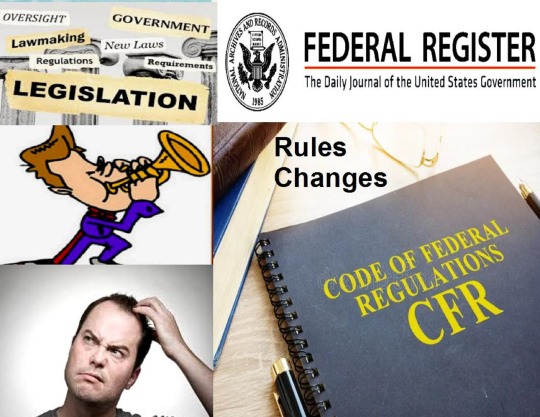
View On WordPress
0 notes
Text







TW: Heavily implied Child Abuse
Stowaway AU where Pacifica becomes a stowaway on the Stan-O-War 2 after trying to run away from home to California. Things don’t exactly work out as planned, but at least she’s got a “Summer Internship” away from her parents now!
#gravity falls#Pacifica Northwest#Stanley Pines#Stanford Pines#Stowaway AU#my art#doodles#sorry I’ve been gone a while been busy with project and just plain general work#but had some free time today and finally put pen to paper on an idea I’ve had a for a while now!#Pacifica calls Stan by his name but still calls Ford Mr Pines because she’s got that ettiquette and fear of authority ingrained in her#but Stan is a bugger so she feels better just calling him Stan lol#this is honestly just a roundabout way of saying Stan is naturally good with kids I think#the more paternal grunkle lol#Also I feel like ghost rules in the show are ghosts can change their perception based on how powerful they are#since sometimes they’re invisible or unseen by people unless the ghost wills it (i.e. inconveniencing)#but Pacifica’s just too ghost pilled so she’s always seeing them regardless#Ford is very interested in the science of how this works and Stan has to remind him she’s still trying to get over trauma give her a second#I feel like after this summer at least specifically for this AU she’d end up staying with either Soo and Melody or the Corduroys#Soos might even say they’re siblings since he also sees Stan as a father figure and then Pacifica says ‘dang guess I gotta go die now’#from embarrassment lol
3K notes
·
View notes
Text
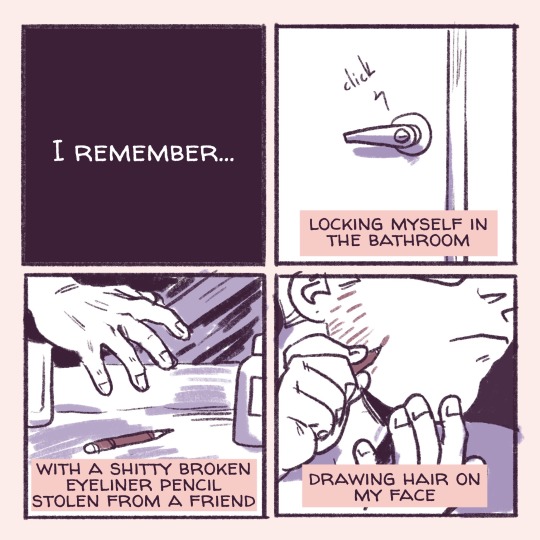
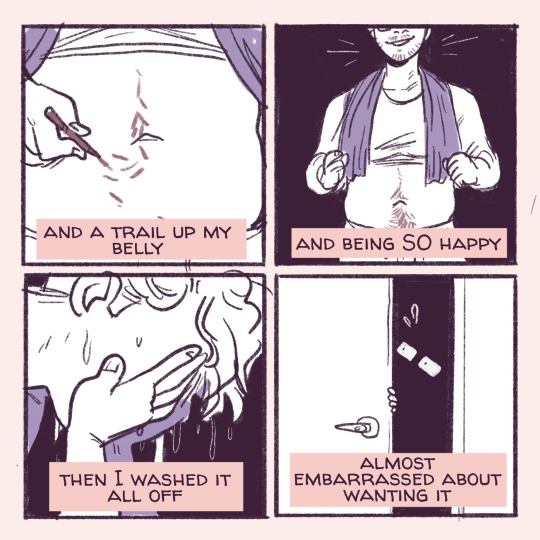
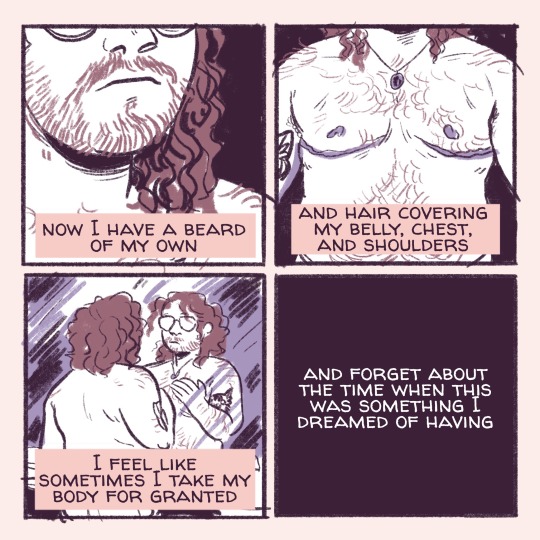
a day late to my 6 years on t anniversary ✨🏳️⚧️ a short comic about looking back
#trans pride#transmasc#comics#autobio comics#transgender#this reads a little more melancholy than I meant it to!#I think I forget how far I’ve come#like oh yeah this rules actually my body’s changed so much#also I grew my hair out and I’m less blond now#anyway I love being on testosterone :)#life saving magic potion that makes you hot and happy#my art#Magnus post art at a reasonable hour challenge (impossible)
77K notes
·
View notes
Text
Eurovision Chat Over Coffee, Discussing Malmö's Eurovision Changes
Eurovision Chat Over Coffee, Discussing Malmö's Eurovision. Changes. With today's news about the format of the Semi Finals and the Grand Final of the Eurovision Song Contest, Ben Robertson and Ewan Spence talk about the key points and how they will impact the performers, the production team, and the public. Eurovision Chat Over Coffee, Discussing Malmö's Eurovision Changes Voting from the first Grand Final Song, the automatic qualifiers perform live in the Semi Finals, the Rest Of The World gets more time to vote, and more, all discussed over a coffee.
With today’s news about the format of the Semi Finals and the Grand Final of the Eurovision Song Contest, Ben Robertson and Ewan Spence talk about the key points and how they will impact the performers, the production team, and the public. Eurovision Chat Over Coffee, Discussing Malmö’s Eurovision Changes Voting from the first Grand Final Song, the automatic qualifiers perform live in the Semi…

View On WordPress
#big 5#chat#esc#eurovision#grand final#host country#malmo 2024#rule changes#semi final#talk#voting.rest of the world
0 notes
Text

An illuminated manuscript from a gossip pamphlet found in the First Talon’s desk with the caption reads:
The Treviso Tourney - Knight Takes Rook
Despite the recently crowned King Viago’s presence at this weekend’s coronation tournament, the audience seemed more enamoured with the rare appearance of the newly wed Dellamorte’s. The Champion of Treviso’s magical talents may have left her out of the competition, but the First Talon’s blade received Rook’s favour - and this punter knows to never bet against the Rook!


#I know Treviso must be SIIICKKK of these two#OHHHH the audience wanting to see the Demon fight meanwhile lucanis is mf sweatin like Spite please do not come out in front of everyone#rook sitting in the house dais like we have GOT to change the rules I would obliterate this lot if you’d let me compete#She also has a disgustingly large bet on Lucanis so he better FKN win#no one critique my botched writing job okay I am an artist not a writer#but sometimes we all need cringey gossip columns written about our favs it’s curative#dragon age veilguard#lucanis dellamorte#dragon age#datv#rookanis#lucanis x rook#rook#lucanis dragon age#rook dragon age#rook mercar#Vivienne rook mercar#dragon age fanart#my art
1K notes
·
View notes
Text
I love tornado survival guides. "Shelter in a basement or interior room without any windows. But if you're in a mobile home, just fucking die I guess lol"
#did you know over half of deaths caused by tornados are residents of mobile homes?#which also means that they're primarily poor and elderly and disabled people#most places have absolutely no requirements for trailer parks to have safe shelter for residents during a tornado#personal tornado shelters cost $5000+ and many of them can't be installed in trailer parks because of neighborhood rules#and many parks are so isolated that going to find shelter somewhere else isn't safe or possible#it's safer to shelter inside a ditch outside than to stay in a mobile home during a tornado#and yet there's next to no effort to change laws to make trailer parks safer especially in emergencies#or even make other housing more accessible and available so people don't have to live in homes made of tissue paper#there's no tornado happening i'm just stressed
3K notes
·
View notes
Note
I'm not perfectly clear if the rules allow for Kohakiha or similar pairs.
Look, I’m going to be completely honest, the original purpose of this tournament was to look at official Type-Moon couples, but after much consideration on my part it’d be extremely close minded of me to keep it like that. So, here’s my new stance on the matter:
Normal ships will now be considered as couples and thus be allowed to enter this tournament as well, as long as it can be proven in canon (This essentially allows ships as the previously mentioned Kohaku x Akiha to be enlisted into the tournament. Of course, official couples will always have priority in this tournament, but if I believe that the argument for a pairing is strong enough then they’ll be included as well. I only ask that the pairing have some actual backing to it from the story itself for it to qualify in this tournament, this unfortunately means that crack shipping is off the table for this tournament since the characters need at least some chemistry with each other)
With this, Rule 4 has changed.
#ask#anonymous#anon ask#tournament preparation#rule changes#remember that if you don’t know something then just ask#who knows? someone might share the same question as you#maybe your question could cause a rule change too? you just need to ask if you have questions#akiha tohno#kohaku
1 note
·
View note
Text

Recently (finally) upgraded Cement to E2! She's got one of my favourite designs, and I've been having a blast with her!
Was inspired to draw her after being directed to @frostdemigod 's blog after raving about her. I am kneeling out of respect for that dedication
[Bluesky]
#frostdemigod there's not enough Cement content in the world and you are carrying hard! I hope you enjoy my little contribution to it!#Cement's design absolutely rules!! I changed it up a little bit here just for fun#I started drawing these “tacticalknights” at the end of last year! I'll post em all eventually!#digital art#arknights#artists on tumblr#art#sketch#Cement#Cement arknights
1K notes
·
View notes
Text
FAR Council Updates Whistle Blower And Small Business Contracting Program Rules
Enhanced Whistle Blower Protections, update and clarification to 8(a) Business Development Program and proposed rule for for protesting Size and Socioeconomic Status categories.”
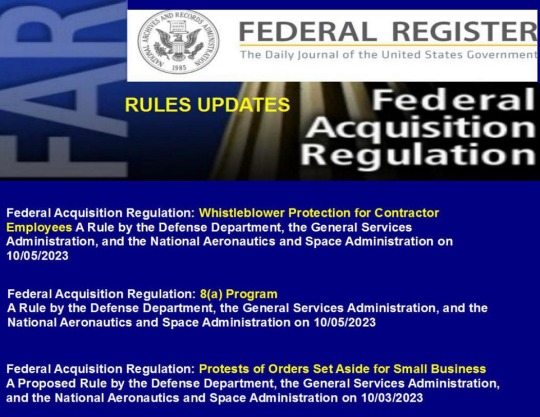
View On WordPress
0 notes
Text
National League Manager Once Again Calls For Rule Change
Barnet manager Dean Brennan once again expressed his desire for National League clubs to be able to make five substitutions and have seven players named on the bench when he appeared on an episode of BBC Sounds’ ‘The London Sport Show.’ This is now the third time this season that the Irishman has called on the rule change to be implemented after also mentioning it on BT Sport after Barnet’s 2-0…

View On WordPress
#Barnet fc#County Cups#dean brennan#national league news#Rule Changes#Substitutions#The National League
0 notes
Text

a new star
#i been thinkin about the asteroid again#i think about the asteroid a lot more than i think is normal#like just the complete randomness of it and how everything changed in literally the blink of an eye#like the dinoss rules the fucking earth and probably still would if space had just been a little bit different#how long did it take the asteroid to reach us#at what point was the impact inevitable#like these sound like scientific answers but i need you to know these are questions that my soul wants answered in poetry#yes the math is cool but can i talk about what tragedy looks like melted into the earth#how power and pain and mourning but also change and new life and a future were embedded in a layer of iridum that spread around the planet#can we talk about how looking at the layers of the earth is the most physical type of time travel there is#can i please talk about that layer of pain#can i mourn when i see it#or am i just a weird kid crying when i look at rocks#ALSO. was parasaurolophus alive when the asteroid hit? i dont think so#but it's too late#yall get to suffer with me#dinosaurs
2K notes
·
View notes